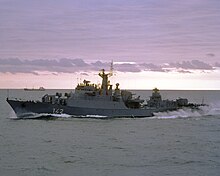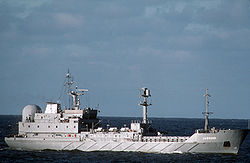

This article includes a list of general references, but it lacks sufficient corresponding inline citations. Please help to improve this article by introducing more precise citations. (January 2013) (Learn how and when to remove this message)
|
| People's Navy Volksmarine | |
|---|---|

Insignia of the Volksmarine
| |
| Active | 1 March 1956 – 2 October 1990 |
| Country | |
| Branch | Ministry of National Defence |
| Type | Navy |
| Role | Coastal defence |
| Size | 27,000 |
| Part of | |
| Headquarters | Rostock |
| March | Präsentiermarsch der Volksmarine |
| Engagements | Cold War |
| Decorations | See article |
| Commanders | |
| Commanders | See list
|
| Insignia | |
| Naval ensign (warships) (1960–1990) |  |
| Naval ensign (auxiliary ships) (1960-1990) |  |
| Naval jack (1960–1990)[1] |  |

The Volksmarine (VM, German pronunciation: [ˈfɔlksmaˌʁiːne]; English: People's Navy) was the naval force of the German Democratic Republic (GDR) from 1956 to 1990. The Volksmarine was one of the service branches of the National People's Army and primarily performed a coastal defence role along the GDR's Baltic Sea coastline and territorial waters.
Disbanded one day before the official reunification of Germany, the Volksmarine served as the naval arm of the East German state for 34 years. Rostock, former home port and headquarters of the Volksmarine, houses Navy Command for the post-reunification Deutsche Marine.

Soon after the end of World War II and the beginning of the Cold War, the Soviet Union initiated the rearming of the German Democratic Republic (GDR), which had been founded in October 1949 as a satellite state from the Soviet Zone of Occupation. Beginning in 1950, Soviet Navy officers helped to establish the Hauptverwaltung Seepolizei (Main Administration Sea Police), which was renamed Volkspolizei–See (VP–See) (People's Police – Sea) on 1 July 1952. At the same time parts of the erstwhile maritime police were reorganized into the new Grenzpolizei–See (Border Police –– Sea), to guard the sea frontiers, and incorporated into the Deutsche Grenzpolizei (German Border Police) that had been set up in 1946. By 1952 the VP–See is estimated to have numbered some 8,000 personnel.
On 1 March 1956, the GDR formally created its armed forces, the National People's Army (Nationale Volksarmee, NVA), and the VP–See became the Verwaltung Seestreitkräfte der NVA (Maritime Forces Administration of the NVA) with about 10,000 men. In November 1960, these maritime forces of the National People's Army were officially designated Volksmarine (People's Navy). Over the next years the navy gradually received a number of new ships, mostly built in the GDR. Only the coastal protection ships and some of the fast torpedo boats were provided by the Soviet Union, as were all helicopters, and some auxiliary craft were purchased from Poland.
Following the erection of the Berlin Wall on 13 August 1961, the Grenzbrigade Küste der Grenzpolizei (GBK) (Coastal Border Brigade of the Border Police) was incorporated into the Volksmarine. With the reorganization of 1965 all attack forces, i.e., the fast torpedo boats, were combined into a single flotilla (the 6th Flotilla) and stationed on the Bug peninsula of the island of Rügen. In the 1970s, the Volksmarine had grown to about 18,000 men. In the 1980s some of the ships were replaced and the Volksmarine acquired Soviet-built fighter-bombers. During 1985 – 1989, the Volksmarine caused about 180 reported incidents due to a maritime border dispute with Poland in the Pomeranian bay; in subsequent negotiations about two thirds of the disputed maritime area were allocated to the GDR.[2][3]
The Volksmarine was dissolved, like all other branches of the former National People's Army, on 2 October 1990 – the day before the official reunification of Germany. Some of its staff was absorbed into the Bundesmarine (which was henceforth called the Deutsche Marine), some by the German Border Police. Most of the ships and other equipment were scrapped or sold; about one third of the ships went to the Indonesian Navy.[4] Few if any former Volksmarine vessels remain in service with the modern-day German Navy. The last commander of the Volksmarine, Vizeadmiral Hendrik Born, wrote a multi-paragraph commentary for Dieter Flohr and Peter Seemann's 2009 book, Die Volksmarine, a comprehensive and picture-oriented history of the Volksmarine.
The Volksmarine was first and foremost a coastal defence force, but offensive action and amphibious assaults against NATO were also included in its training and plans. It was operationally incorporated into the United Baltic Sea Fleets of the Warsaw Pact states, intended to serve alongside them in the event of war. Its designated area of operations was the Baltic Sea and the entrances to the Baltic Sea. If open warfare had erupted between the Warsaw Pact and NATO, the primary mission of the Volksmarine was to keep the sea lanes open for Soviet reinforcements and to participate in offensive actions against the coasts of hostile nations in the Baltic Sea. For these purposes, it was equipped with light forces such as anti-submarine ships, fast torpedo boats, minesweepers as well as landing craft. Routine duty was heavily focused on extensive reconnaissance activities, carried out mainly by the minesweepers and specialized electronic surveillance boats.
The 6th Border Brigade (Coast) had a special responsibility for the prevention of "Republikflucht" (people leaving the GDR without official permission). With effect from 1 November 1961, it was subordinated to the Volksmarine. It had a substantial number of small patrol boats and surveillance posts along the coast.

The Volksmarine was headed by the Kommando der Volksmarine (People's Navy HQ Command) in Rostock-Gehlsdorf. It was structured as follows (in 1985):
Shore-based forces consisted of:




The Volksmarine was equipped with:
The People's Navy's band played a number of specially-composed musical pieces. Most notable is the "Präsentiermarsch der Volksmarine", which was composed by Ludwig Schmidt for use at ceremonial events. "Unsere Volksmarine" was also written for use at parades, while "Matrosen von Kronstadt" was an East German adaptation of the 1926 Soviet Navy song "Forward, Red Marines". The instrumental pieces written for the Volksmarine fell out of use after the reunification of Germany, and are not used by the modern German Navy.

There were 37 admirals in the history of the Volksmarine and its predecessor organizations. They were:
No one was awarded this rank.

|
German Navies
| |
|---|---|
| Pre–unification German states |
|
| German Confederation |
|
| North German Confederation |
|
| German Empire |
|
| Weimar Republic |
|
| Nazi Germany |
|
| Allied–occupied Germany |
|
| Post WWII German Navy |
|
| International |
|
|---|---|
| National |
|